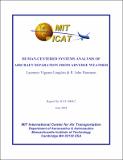Human-Centered Systems Analysis of Aircraft Separation from Adverse Weather
Author(s)
Vigeant-Langlois, Laurence; Hansman, R. John
DownloadLaurence.pdf (5.649Mb)
Metadata
Show full item recordAbstract
Adverse weather significantly impacts the safety and efficiency of flight operations. Weather information
plays a key role in mitigating the impact of adverse weather on flight operations by supporting air
transportation decision-makers’ awareness of operational and mission risks. The emergence of new
technologies for the surveillance, modeling, dissemination and presentation of information provides
opportunities for improving both weather information and user decision-making. In order to support the
development of new weather information systems, it is important to understand this complex problem
thoroughly.
This thesis applies a human-centered systems engineering approach to study the problem of separating
aircraft from adverse weather. The approach explicitly considers the role of the human operator as part of
the larger operational system. A series of models describing the interaction of the key elements of the
adverse aircraft-weather encounter problem and a framework that characterizes users’ temporal decisionmaking
were developed. Another framework that better matches pilots’ perspectives compared to
traditional forecast verification methods articulated the value of forecast valid time according to a spacetime
reference frame. The models and frameworks were validated using focused interviews with ten
national subject matter experts in aviation meteorology or flight operations. The experts unanimously
supported the general structure of the models and made suggestions on clarifications and refinements
which were integrated in the final models.
In addition, a cognitive walk-through of three adverse aircraft-weather encounters was conducted to
provide an experiential perspective on the aviation weather problem. The scenarios were chosen to
represent three of the most significant aviation weather hazards: icing, convective weather and low
ceilings and visibility. They were built on actual meteorological information and the missions and pilot
decisions were synthesized to investigate important weather encounter events. The cognitive walkthrough
and the models were then used to identify opportunities for improving weather information and
training. Of these, the most significant include opportunities to address users’ four-dimensional trajectorycentric
perspectives and opportunities to improve the ability of pilots to make contingency plans when
dealing with stochastic information.
Date issued
2004-06Series/Report no.
ICAT-2004-2
Keywords
Adverse weather, flight operations, Air Transportation, weather information systems